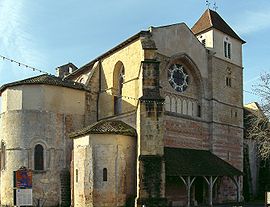Sorde-l'Abbaye
Sorde-l'Abbaye | |
|---|---|
 Abbey of Saint-Jean de Sorde | |
| Coordinates: 43°31′47″N 1°03′10″W / 43.5297°N 1.0528°W | |
| Country | France |
| Region | Nouvelle-Aquitaine |
| Department | Landes |
| Arrondissement | Dax |
| Canton | Orthe et Arrigans |
| Intercommunality | Pays d'Orthe et Arrigans |
| Government | |
| • Mayor (2020–2026) | Marie-Françoise Laborde[1] |
| Area 1 | 16.34 km2 (6.31 sq mi) |
| Population (2021)[2] | 628 |
| • Density | 38/km2 (100/sq mi) |
| Time zone | UTC+01:00 (CET) |
| • Summer (DST) | UTC+02:00 (CEST) |
| INSEE/Postal code | 40306 /40300 |
| Elevation | 2–135 m (6.6–442.9 ft) (avg. 8 m or 26 ft) |
| 1 French Land Register data, which excludes lakes, ponds, glaciers > 1 km2 (0.386 sq mi or 247 acres) and river estuaries. | |
Sorde-l'Abbaye (French pronunciation: [sɔʁd labei]; Occitan: Sòrda l'Abadia) is a commune, in the department of Landes and the region of Nouvelle-Aquitaine in southwestern France.[3]
Geography
The commune is situated on the edge of the Pays d'Orthe, a territory which was once under the control of the vicomté de Gascogne. These lands are irrigated by the
History
Situated on the
The site of Barat-de-Vin (in Gascon, "barat de bi") not far from the village, has been a thoroughfare for at least two thousand years, and was inhabited by ancient man who would have been attracted by the fertility of the Adour river valley.
At the foot of a cliff on this site, several prehistoric deposits yielded remarkable artefacts of the
.In
In the area around Sorde, there are several places where the two rivers can be crossed by boat. The
However much the river was a problem for pilgrims, it was also an economic asset for local inhabitants. The water was exploited with watermills as well as salmon traps, or "baros", which were devised by
Population
| Year | Pop. | ±% p.a. |
|---|---|---|
| 1968 | 637 | — |
| 1975 | 616 | −0.48% |
| 1982 | 572 | −1.05% |
| 1990 | 569 | −0.07% |
| 1999 | 535 | −0.68% |
| 2009 | 646 | +1.90% |
| 2014 | 657 | +0.34% |
| 2020 | 619 | −0.99% |
| Source: INSEE[4] | ||
Sights

The Gallo-Roman mosaics of Sorde are found at the abbot's house of the abbey of St John, which is behind the church. Some fragments were found around 1870 but most were discovered starting in 1957, particularly during excavations which took places from 1958 to 1966. All the mosaics are registered as historic monuments.
These marble mosaics were part of a Gallo-Roman villa which was probably constructed in the 3rd century. There is no remaining trace of the villa walls in the courtyard of the abbot's house, but the interior of the
-
-
-
-
Pierced bear tooth
-
Pierced lion tooth
-
Cave bear canine pierced and engraved with a representation of pike.
See also
References
- ^ "Répertoire national des élus: les maires" (in French). data.gouv.fr, Plateforme ouverte des données publiques françaises. 13 September 2022.
- ^ "Populations légales 2021". The National Institute of Statistics and Economic Studies. 28 December 2023.
- ^ INSEE commune file
- ^ Population en historique depuis 1968, INSEE
External links
- Community of the communes of the Pays d'Orthe
- Sorde l'Abbaye on the official site of the Centre Culturel du Pays d'Orthe
- Office of Tourism of the Pays d'Orthe









